Philosophical geometry. Part 3. The root of the two and the perfect laptop
Not all the spears have broken over the iPhone, inscribed in an ancient sacral figure, as my continuation is ready for me. Under the cut, I'll show you how modern subjects still use ideas from centuries ago.
This article is a continuation of the first two.
“ At first there was a review where I spoke as the ancient geometers were looking for the unchanging in everything and embodied it in works of art.”
- Then there was an article where I showed how the number √3 was used in religious symbols and a contemporary design object known to all
This talk about the number √2. The root of the two is a symbol of natural growth. A visual representation of a geometric progression shows how a tiny object can grow to gigantic sizes in a short time. The root of the two is the unchanging that is at the heart of this progression. In this growth is the strength of a given number.
')

But what is growth? What is the process of creation in general and how can the insignificant develop and become large? Let's imagine the point.

In itself, this is nothingness. This is an entity that is present in one dimension, but at the same time, it contains tremendous energy. Let's free her.

What's next? We need a breakthrough. Let's discover the second dimension. Construct the square ABCD

Now, we will open new forms of movement. With the center at point C with radius CB, let's draw an arc.

We will find new ways of movement. Connect AC and CE. AC length is a √2 factor that doubles the measurement.
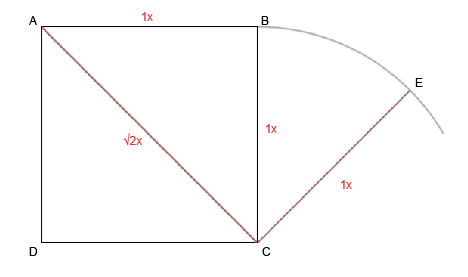
What does this lead to? To an infinite set of things. But let's take a practical task. Under the cut, we will grow the perfect laptop. (You can not even doubt whose logo will be there :)
So, once you get to Kata, we will continue to create a laptop.
Let's draw the line AE.
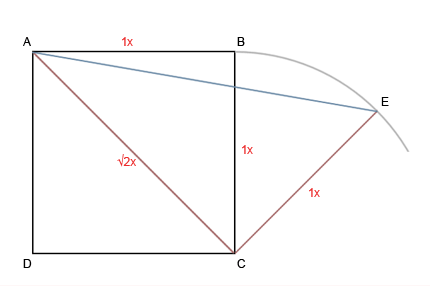
Now, symmetrically reflect our recent construction.
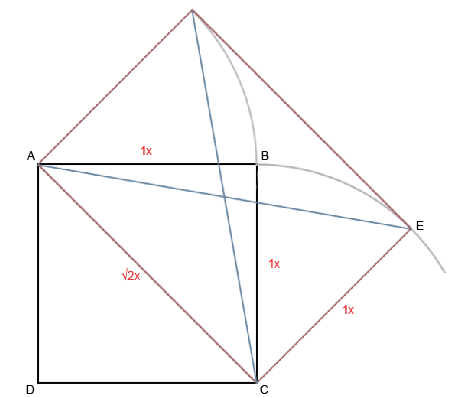
Now take a look at them in more detail.

Well, the form is born by itself.

But stand still! Why do we need such difficulties? Naka was generally dragging organics here, biology, and what else did the author’s diseased brain invent? In the end, increase the A4 sheet - and here's the whole philosophy.
But not everything is so simple as the task becomes more complicated. Let's open the laptop. We somehow need to arrange a bunch of functional elements that it has. How to place them?
Very simple. We have just drawn a natural and beautiful mesh that is based on the mighty power of the growth symbol. We use it.
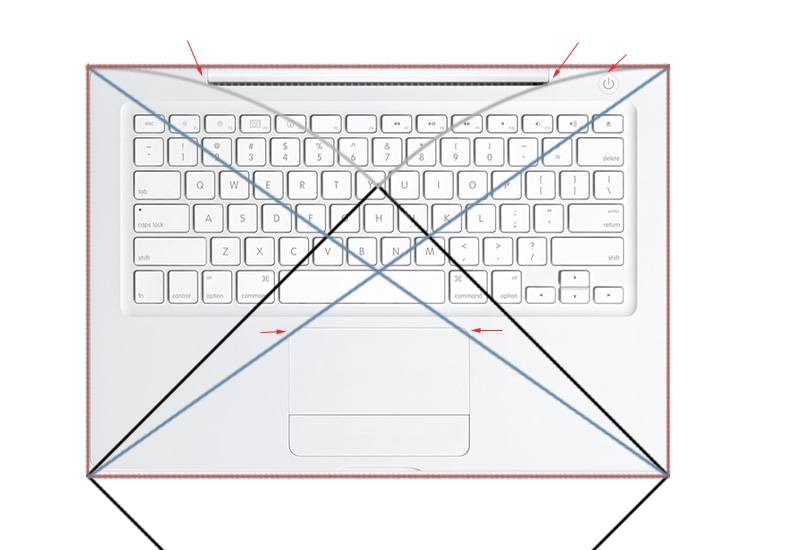
MacBook is without a doubt a very beautiful piece of design art. I personally like the beauty of this element.

Of course, the grid of the location of all the elements on the MacBook is much more complicated, and we did not even try to go into the third dimension. However, the eye still catches some patterns.
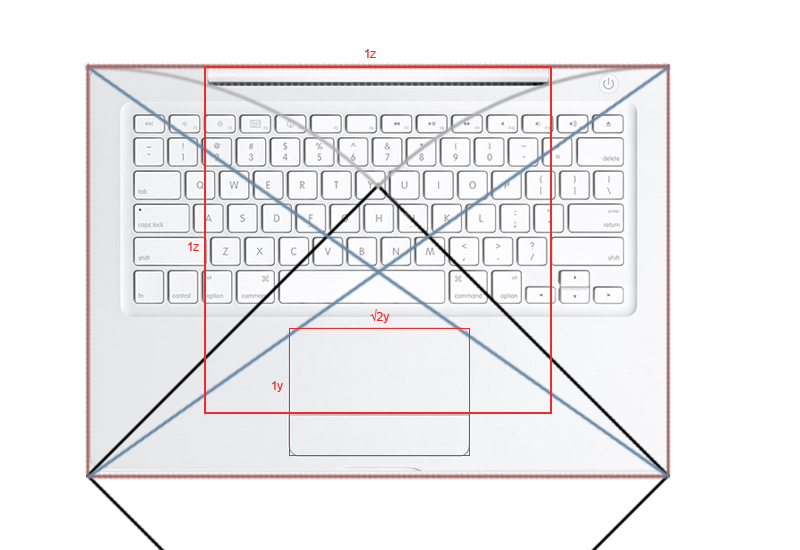
So, we saw how the growth philosophy can be applied to industrial design. This is a very simple and natural philosophy. Actually, our brain works in a similar way. Having a certain starting point, he seeks in certain directions. Thinking thought branches like tree roots in different directions. When the roots of this tree reach the water - this is the solution. When they form patterns, that's beauty.
Similar patterns enclosed in constructions are a science that has been practiced in geometry for many centuries. Seeing coincidences in this, general laws, technical proportions, or God - is left to the discretion of each individual person. It is important that there seems to be something unifying nature, people and human creations.
From this thought follows. Nature created the world, surprisingly harmoniously interacting with each other. Can a person do the same with his creations? And how to make a profit out of it?
As already noted, the size of the MacBook is close to an A4 sheet. The sides of such a sheet are referred to as √2 / 1. Proportionality can be geometrically checked by drawing a diagonal between opposite corners of the object. If the second object stands on them - it is proportional to the first.

The proportionality of the company's products leads to the fact that they become easy to use in promotional materials. Located in a row on an advertisement or in a shop window, they are in harmony with each other. Several products begin to appear as one, one, integrated into one system.
Apple, by the way, did just that. Both the new macbook and the old white one, and the macbook eyr they have the same size. And the MacBook Pro is as close as possible to them in proportions, although not completely.

But what about the rest? In the end, the planet is full of brilliant designers. Let's take the Sony Vaio - great popular beautiful laptops. How do they interact with each other? Do they create a sense of the whole?
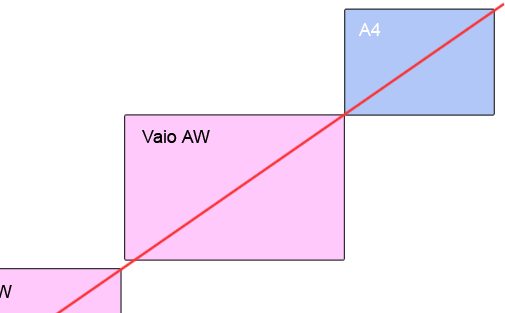

On such a scale, it is not very clearly visible, but if one considers the numerical values of the ratio of their sides, one can see that there is no, they are not proportional to each other.
Let's take the other good laptops - Toshiba. I'll draw two things here. This is sufficient for a general illustration of the situation.

This is just a test of respect for proportion, but if we compare the sites of three companies, the general impression about them will be about the same. If Apple is whole, and Sony is good, then Toshiba plunged me into a slight depression.
When several things are present in one thing unchanged, it produces a beautiful balanced system of many things. It can be used in design, advertising, marketing and other human activities. The very way of thinking of a person works in a similar way, and in two directions. At the beginning of the article I showed how from a negligibly small nature and a man can build a large one. At the end of the article I showed how the products of these buildings can be perceived by a person on an unconscious level. If he finds a way back to the small in them, then maybe this means that he has found beauty?
This article is a continuation of the first two.
“ At first there was a review where I spoke as the ancient geometers were looking for the unchanging in everything and embodied it in works of art.”
- Then there was an article where I showed how the number √3 was used in religious symbols and a contemporary design object known to all
This talk about the number √2. The root of the two is a symbol of natural growth. A visual representation of a geometric progression shows how a tiny object can grow to gigantic sizes in a short time. The root of the two is the unchanging that is at the heart of this progression. In this growth is the strength of a given number.
')

But what is growth? What is the process of creation in general and how can the insignificant develop and become large? Let's imagine the point.

In itself, this is nothingness. This is an entity that is present in one dimension, but at the same time, it contains tremendous energy. Let's free her.

What's next? We need a breakthrough. Let's discover the second dimension. Construct the square ABCD

Now, we will open new forms of movement. With the center at point C with radius CB, let's draw an arc.

We will find new ways of movement. Connect AC and CE. AC length is a √2 factor that doubles the measurement.

What does this lead to? To an infinite set of things. But let's take a practical task. Under the cut, we will grow the perfect laptop. (You can not even doubt whose logo will be there :)
So, once you get to Kata, we will continue to create a laptop.
Let's draw the line AE.

Now, symmetrically reflect our recent construction.

Now take a look at them in more detail.

Well, the form is born by itself.

But stand still! Why do we need such difficulties? Naka was generally dragging organics here, biology, and what else did the author’s diseased brain invent? In the end, increase the A4 sheet - and here's the whole philosophy.
But not everything is so simple as the task becomes more complicated. Let's open the laptop. We somehow need to arrange a bunch of functional elements that it has. How to place them?
Very simple. We have just drawn a natural and beautiful mesh that is based on the mighty power of the growth symbol. We use it.

MacBook is without a doubt a very beautiful piece of design art. I personally like the beauty of this element.

Of course, the grid of the location of all the elements on the MacBook is much more complicated, and we did not even try to go into the third dimension. However, the eye still catches some patterns.

So, we saw how the growth philosophy can be applied to industrial design. This is a very simple and natural philosophy. Actually, our brain works in a similar way. Having a certain starting point, he seeks in certain directions. Thinking thought branches like tree roots in different directions. When the roots of this tree reach the water - this is the solution. When they form patterns, that's beauty.
Similar patterns enclosed in constructions are a science that has been practiced in geometry for many centuries. Seeing coincidences in this, general laws, technical proportions, or God - is left to the discretion of each individual person. It is important that there seems to be something unifying nature, people and human creations.
From this thought follows. Nature created the world, surprisingly harmoniously interacting with each other. Can a person do the same with his creations? And how to make a profit out of it?
As already noted, the size of the MacBook is close to an A4 sheet. The sides of such a sheet are referred to as √2 / 1. Proportionality can be geometrically checked by drawing a diagonal between opposite corners of the object. If the second object stands on them - it is proportional to the first.

The proportionality of the company's products leads to the fact that they become easy to use in promotional materials. Located in a row on an advertisement or in a shop window, they are in harmony with each other. Several products begin to appear as one, one, integrated into one system.
Apple, by the way, did just that. Both the new macbook and the old white one, and the macbook eyr they have the same size. And the MacBook Pro is as close as possible to them in proportions, although not completely.

But what about the rest? In the end, the planet is full of brilliant designers. Let's take the Sony Vaio - great popular beautiful laptops. How do they interact with each other? Do they create a sense of the whole?


On such a scale, it is not very clearly visible, but if one considers the numerical values of the ratio of their sides, one can see that there is no, they are not proportional to each other.
Let's take the other good laptops - Toshiba. I'll draw two things here. This is sufficient for a general illustration of the situation.

This is just a test of respect for proportion, but if we compare the sites of three companies, the general impression about them will be about the same. If Apple is whole, and Sony is good, then Toshiba plunged me into a slight depression.
When several things are present in one thing unchanged, it produces a beautiful balanced system of many things. It can be used in design, advertising, marketing and other human activities. The very way of thinking of a person works in a similar way, and in two directions. At the beginning of the article I showed how from a negligibly small nature and a man can build a large one. At the end of the article I showed how the products of these buildings can be perceived by a person on an unconscious level. If he finds a way back to the small in them, then maybe this means that he has found beauty?
Source: https://habr.com/ru/post/57526/
All Articles